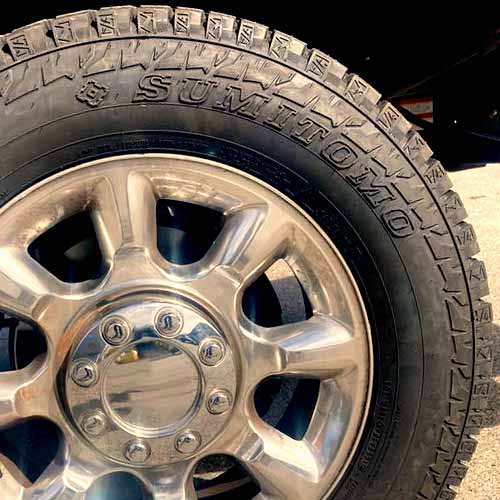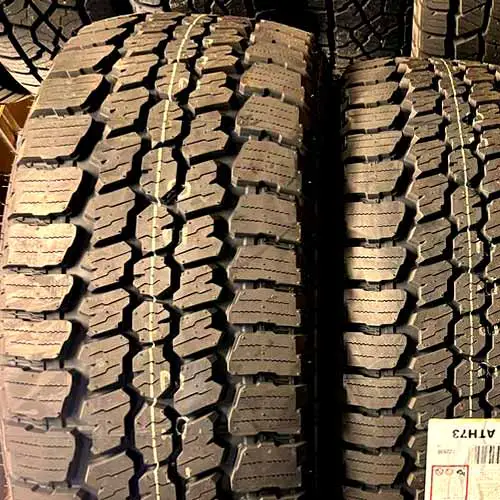The Japanese Sumitomo Encounter AT is an well engineered all-terrain tire, that provides you with an impressive performance, particularly, when it comes to wet asphalts. But how well it does in other key areas? Let’s find out.

As a tire engineer, I find the Sumitomo Encounter AT notably impressive on wet surfaces, a domain where many all-terrain (A/T) tires typically fall short. Moreover, its performance on dry roads is also appreciable. Designed for all-season use, it offers the 3 Peak Mountain Snowflake rating, indicating its suitability for snowy conditions. However, its off-road capabilities have some limitations: it performs poorly in muddy environments, is average on rocky terrain, and fares better in sandy dunes.
Table of Contents
Quick Facts
- The tire comes in 15 to 20 inches (wheel diameter) rims.
- Speed ratings: Q, R, S and T.
- Load Ratings: SL, XL, C, D, and E
- Weight varies form 34 to 84 lbs.
- Tread depth range: 13 to 20/32″
- Warranty: 60k miles for all sizes
- Winter Ratings: 3PMSF and M+S.
Tread Features
Sumitomo Encounter AT offers 3 ribs in the middle and wide elongated shoulder lugs on sides.

Let’s start form the sides.
You must have already seen that there’s not too much to talk about on sidewalls (see above), as the tire makes an insignificant pattern over there.
Speaking of shoulder lugs, these have a lot of off-set edges, and sharp sides.
Moreover, they are although not staggered, each blocks is serrated on itself.
All these blocks here are joined together with rubber ridges in between, enhancing handling stability.
Moreover, they also feature very aggressive wave-like sipes too, unlike the central blocks, which have linear structures.
Speaking of which, you get 3 ribs/block columns in the middle part of the tread.
Here the lugs are although independent, they are still interconnected to each other longitudinally, by a secondary rubber layer, acting as reinforced foundation.
And yes, as you can see (from its tread image), you get a ton of biters on these lugs as well.
Compare Sumitomo Encounter A/T with others
- General Grabber A/TX.
- BF Goodrich KO2.
- Yokohama Geolandar A/T G015
- Cooper Discoverer AT3
- Falken Wildpeak AT3W
- Sumitomo Encounter HT
Highway Performance
Highway performance depends on tire’s steering responsiveness, and overall traction, which includes directional and lateral grip.
Let’s see how this tire performed in each of these crucial dry performance components.
Overall Traction
The dry grip of the tire is dependent on the contact patch it makes with the road. So with more rubber meeting with the surface, you get better friction, and therefore grip.
Having said that the Encounter AT isn’t able to form good enough road contact, mainly because of the prominent lateral grooves between the blocks.
Now, this goes particularly for the lugs in the middle, where you see the central most rib, being the narrowest of them all, and having a lot of tread elements, along with grooves.
Since this defines directional grip, it makes sense why the tire lacks by over 3 feet (on braking distances, on average), compared to the best rated tire in its category.
Basically, while the tire rolls straight, the central lugs make the most contact with the road, and when it starts to corner, the weight on it shifts towards shoulders.
That’s why for lateral grip, the shoulder/sidewall area making the most contact (while the tire is turning), defines lateral grip.
That’s why the Sumitomo AT with more packed up and bulky shoulder lugs provide good enough overall lateral traction values (as seen by lateral g forces, on average).
Dry Handling
Dry handling is the sum of tire’s lateral grip with its steering responsiveness. And as already explained the Sumitomo Encounter AT is doing a good enough job in the first half (providing adequate lateral traction).
Though the second half could still be improved a bit, according to my subjective evaluations, as the tire faces some lag (in giving out feedback), and is prone to understeering.
This is predominately, due to its significant weight, pushing down on lugs more, causing them to bend.
This bending basically results in vagueness of the overall steering, especially when it comes to mid-cornering feedback (when the tire is at the apex of a turn).
In simpler terms, its not able to convey, how much traction is at disposal, and so you end up with lacking overall handling times, as seen on lap tests, with this tire.
Wet Performance
On wet roads, 2 main things are important to note, the overall wet traction of the tire, and hydroplaning.
Let’s talk both.
Wet Traction
Wet traction is not easy to achieve for aggressive off road tires, but there are few really great off roaders that are very capable for providing you considerable grip, and Sumitomo Encounter A/T is one of them.
Under average conditions in heavy rain, you don’t need traction control of you truck, even with sharp cornering and braking, as this tire offers massive shoulders filled with interlocking full depth sipes.
Such design of sipes allow them to contract and expand differently at different points (with g forces), so they stay flexible enough to suck in the water particles and wipe water away.
(Basically when these slits meet with the road, they create vacuum, and all water is sucked it, and later sprayed out, when the tire goes back in to the air).
Sumitomo Encounter AT also offers dual siping, so where these sipes on shoulder offer ample lateral traction, the one in the middle of the tread deal with directional.
Hydroplaning
Hydroplaning is often underrated, where in fact its very crucial for overall wet traction. It’s calculated by float speed which tells how fast can you move on water without floating.
The Sumitomo Encounter AT offer 4 longitudinal channels with good enough tread depth reaching up to 20/32″.
These channels are also interlinked with each other with lateral grooves (which makes blocks), so water leaves the tire very quickly, enhancing it’s overall resistance to aquaplaning.
Fuel Usage and Tread Wear
Fuel efficiency is linked with rolling resistance of the tire, which is then related to various factors like weight, tread depth, tread composition and so on.
Overall, the Sumitomo Encounter AT does not impress in this area, this is because the tire is a little heavier for an A/T, and it’s softer rubber sticks on the surface (where it does not want to leave the surface easily).
This is further enhanced with the tread depth, which is a lot on this tire, reaching up to 20/32″, (as larger depth causes stickiness of its own).
So the tire consumes more than average amount of fuel to move.
The larger rolling resistance of the tire also affects the tread wear, and Encounter A/T has a softer rubber, so it has to deal with faster wear as well.
That’s why the tire offers such large tread depth values, and with it a confidence inspiring 60k miles warranty. This reminds me, one of the top tires for tread wear in A/T category, is General Grabber A/TX, you can review the tire here: https://tiredriver.com/general-grabber-atx-review/
Comfort And Noise
The Sumitomo Encounter AT offers a great mixture of polymers in it’s tread which removes rigidity form the tire and adds elasticity to it.
With this, its able to remain soft without being prone to wear as well.
So with a softer rubber the tire is quite efficient to soak up the vibrations of the road nicely. These on road vibrations also have a lot of room to dissipate as well as the tire offers tread depth of 20/32″ (a lot in the A/T category).
But this tread depth also makes noise as air has a lot of room to hit the walls, though with ridges between the shoulder lugs the tire resist a lot of this air to come in the tire (most of the air enters through the shoulders).
Encounter A/T also yields variable pitch technology where it’s lugs at different points generated different tones, so sound is not amplified.
Both of these allow very significant reduction of noise.
Winter Traction:
All-Terrain (A/T) tires perform very good on snowy terrains. That’s because they implement a lot of tread features of winter tires.
Some of the most impacting ones include having a spongy rubber which would remain soft with winter temperatures, a lot of sipes, and a lot of notches which can trap the snow.
The Encounter A/T offers all these features that’s why the tire earns 3 Peak Mountain Snowflake and M+S symbols.
Besides having a soft rubber and a lot of siping (with dual design), the grooves and biters of the tire grab the snow particles and make contact on snow with this lodged snow, to provide ample braking, acceleration and handling performance.
Though it’s not as capable with deeper snow and for that I really recommend Goodyear Wrangler DuraTrac (review).
Off Road Performance
Off road is a tough one for this tire, as it’s very much aligned towards on road.
Let’s check out all the terrains and tire’s performance on them.
Rocks
First stop, rocks. Now rocky terrains have a lot of sub categories, there are stones, dirt, big rocks, gravely roads and much more, so I am going to try to cover them all.
For dirt and stones, the tire does not offer any stone ejectors, though it’s rubber is chip resistant, so although the ride is very bumpy, the overall performance is not too bad, even with higher speeds above 40 mph.
For climbing on rocks however, don’t expect too much from this tire. It’s directional traction here is not a lot even with lowered air pressure.
The sidewall lugs are also almost non existent, so the lateral traction component is also affected.
And as one of the most important factors on rocks is durability, the tire is also average here with just 2 ply sidewalls and no lugs to protect them from outside either.
Sand
On sand, the tire is good with lighter terrains, as it focuses on forward momentum instead of digging with it’s smooth lugs.
Though with missing staggered shoulder lugs, there is no paddling affect provided.
The footprint is also not greatly enhanced with missing sidewall lugs, which is very important when it comes to sand (that’s why balloon tires are used on sandy dunes).
Mud
Mud is a big no here. The tire simply gets stuffed with mud in no time.
Mud needs to leave as soon as possible, as mud on mud provides no traction at all, and a filled with mud tire just slips.
That’s why mud terrain tires are so bald and have traction scoops so mud can get evacuated quickly.
Sumitomo Encounter AT basically has closed up shoulders (as they have tie bars in them), the central lugs also have rubber foundations, so mud has no where to go but to stay in the tread.
Conclusion
Sumitomo Encounter AT although is not so great off road, the tire does amazingly well on roads, making it a perfect choice for SUV and light truck owners in my personal opinion.
The most eye catching feature of this tire is wet traction. I am personally really impressed by it. The handling, braking and acceleration all feel very smooth on it.
Though the tire can improve a few things on dry roads, but it’s only when you see how capable the tire is on wet roads.
You also get all season traction as these tires are 3 peak mountain snowflake rated.